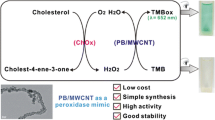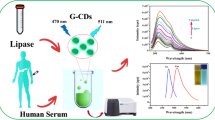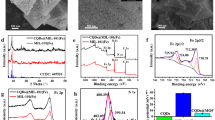Abstract
Carbon dots/Prussian blue nanoparticles (CDs/PBNPs) with fluorescence (FL) performance and peroxidase-like activity are synthesized by a simple two-step method. The FL of CDs/PBNPs can be effectively quenched by Fe3+. Fe3+ can accelerate the peroxidase-like activity of CDs/PBNPs. More excitingly, the peroxidase-like activity of CDs/PBNPs could be further enhanced due to the influence of the photothermal effect. Based on the FL property and enhanced peroxidase-like activity, a cascade strategy is proposed for detection of Fe3+ and free cholesterol. CD/PBNPs act as FL probe for detection of Fe3+. The enhanced peroxidase-like activity of CDs/PBNPs can also be used as colorimetric probe for the detection of free cholesterol. The detection ranges of Fe3+ and free cholesterol are 4–128 μM and 2–39 μM, and the corresponding limit of detections are 2.0 μM and 1.63 μM, respectively. The proposed strategy has been verified by the feasibility determination of Fe3+ and free cholesterol, suggesting its potential in the prediction of disease.
Graphical abstract










Similar content being viewed by others
References
Han C, Wang R, Wang K, Xu H, Sui M et al (2016) Highly fluorescent carbon dots as selective and sensitive “on-off-on” probes for iron(III) ion and apoferritin detection and imaging in living cells. Biosens Bioelectron 83:229–236. https://doi.org/10.1016/j.bios.2016.04.066
Atchudan R, Edison T, Aseer KR, Perumal S, Karthik N, Lee YR (2018) Highly fluorescent nitrogen-doped carbon dots derived from Phyllanthus acidus utilized as a fluorescent probe for label-free selective detection of Fe(3+) ions, live cell imaging and fluorescent ink. Biosens Bioelectron 99:303–311. https://doi.org/10.1016/j.bios.2017.07.076
Xue J, Tian LM, Yang ZY (2019) A novel rhodamine-chromone Schiff-base as turn-on fluorescent probe for the detection of Zn(II) and Fe(III) in different solutions. J Photochem Photobiol A Chem 369:77–84. https://doi.org/10.1016/j.jphotochem.2018.10.026
Wisitsoraat A, Sritongkham P, Karuwan C, Phokharatkul D, Maturos T et al (2010) Fast cholesterol detection using flow injection microfluidic device with functionalized carbon nanotubes based electrochemical sensor. Biosens Bioelectron 26(4):1514–1520. https://doi.org/10.1016/j.bios.2010.07.101
Hayat A, Haider W, Raza Y, Marty JL (2015) Colorimetric cholesterol sensor based on peroxidase like activity of zinc oxide nanoparticles incorporated carbon nanotubes. Talanta 143:157–161. https://doi.org/10.1016/j.talanta.2015.05.051
Bui TT, Park SY (2016) A carbon dot–hemoglobin complex-based biosensor for cholesterol detection. Green Chem 18(15):4245–4253. https://doi.org/10.1039/c6gc00507a
He Y, Niu X, Shi L, Zhao H, Li X et al (2017) Photometric de-termination of free cholesterol via cholesterol oxidase and carbon nanotube supported Prussian blue as a peroxidase mimic. Microchim Acta 184(7):2181–2189. https://doi.org/10.1007/s00604-017-2235-y
Kivipelto M, Helkala EL, Laakso MP, Hanninen T, Hallikainen M et al (2002) Apolipoprotein E epsilon 4 allele, elevated midlife total cholesterol level, and high midlife systolic blood pressure are independent risk factors for late-life Alzheimer disease. Ann Intern Med 137(3):149–155. https://doi.org/10.7326/0003-4819-137-3-200208060-00006
Li ZX, Li HX, Shi CX, Yu MM, Wei LH et al (2016) Nanomolar colorimetric quantitative detection of Fe3+ and PPi with high selectivity. Spectrochim Acta A Mol Biomol Spectrosc 159:249–253. https://doi.org/10.1016/j.saa.2016.02.001
Nirala NR, Abraham S, Kumar V, Bansal A, Srivastava A et al (2015) Colorimetric detection of cholesterol based on highly efficient peroxidase mimetic activity of graphene quantum dots. Sens Actuators B 218:42–50. https://doi.org/10.1016/j.snb.2015.04.091
Jiang YL, Han QR, Jin C, Zhang J, Wang BX (2015) A fluorescence turn-off chemosensor based on N-doped carbon quantum dots for detection of Fe3+ in aqueous solution. Mater Lett 141:366–368. https://doi.org/10.1016/j.matlet.2014.10.168
Bui TT, Park SY (2016) A carbon dot-hemoglobin complex-based biosensor for cholesterol detection. Green Chem 18(15):4245–4253. https://doi.org/10.1039/c6gc00507a
Lee YJ, Park JY (2010) Nonenzymatic free-cholesterol detection via a modified highly sensitive macroporous gold electrode with platinum nanoparticles. Biosens Bioelectron 26(4):1353–1358. https://doi.org/10.1016/j.bios.2010.07.048
Nguyen LD, Doan TCD, Huynh TM, Dang DMT, Dang CM (2021) Thermally reduced graphene/nafion modified platinum disk electrode for trace level electrochemical detection of iron. Microchem 169:106627. https://doi.org/10.1016/j.microc.2021.106627
Andersen JET (2005) A novel method for the filterless preconcentration of iron. Analyst 130(3):385–390. https://doi.org/10.1016/j.microc.2021.106627
Peng X, Wang R, Wang T, Yang W, Wang H, Gu W et al (2018) Carbon dots/Prussian blue satellite/core nanocomposites for optical imaging and photothermal therapy. ACS Appl Mater Interfaces 10(1):1084–1092. https://doi.org/10.1021/acsami.7b14972
Zhou J, Li M, Hou Y, Luo Z, Chen Q et al (2018) Engineering of a nanosized biocatalyst for combined tumor starvation and low-temperature photothermal therapy. ACS Nano 12(3):2858–2872. https://doi.org/10.1021/acsnano.8b00309
Fu GL, Liu W, Li YY, Jiang LG, Liang XL et al (2014) Magnetic Prussian blue nanoparticles for targeted photothermal therapy under magnetic resonance imaging guidance. Bioconjug Chem 25(9):1655–1663. https://doi.org/10.1021/bc500279w
Li WP, Su CH, Tsao LC, Chang CT, Hsu YP et al (2016) Controllable CO-release following near-infrared light-induced cleavage of iron carbonyl derivatized Prussian blue nanoparticles for CO-assisted synergistic treatment. ACS Nano 10(12):11027–11036. https://doi.org/10.1021/acsnano.6b05858
Kim T, Lemaster JE, Chen F, Li J, Jokerst JV (2017) Photoacoustic imaging of human mesenchymal stem cells labeled with Prussian blue-poly(l-lysine) na-nocomplexes. ACS Nano 11(9):9022–9032. https://doi.org/10.1021/acsnano.7b03519
Zhou D, Zeng K, Yang M (2019) Gold nanoparticle-loaded hollow Prussian blue nanoparticles with peroxidase-like activity for colorimetric determination of L-lactic acid. Microchim Acta 186(2):121. https://doi.org/10.1007/s00604-018-3214-7
Chen J, Wang Q, Huang L, Zhang H, Rong K, Zhang H et al (2018) Prussian blue with intrinsic heme-like structure as peroxidase mimic. Nano Res 11(9):4905–4913. https://doi.org/10.1007/s12274-018-2079-8
Komkova MA, Karyakina EE, Karyakin AA (2018) Catalytically synthesized Prussian blue nanoparticles defeating natural enzyme peroxidase. J Am Chem Soc 140(36):11302–11307. https://doi.org/10.1021/jacs.8b05223
Zhang W, Hu S, Yin JJ, He W, Lu W, Ma M et al (2016) Prussian blue nanoparticles as multienzyme mimetics and reactive oxygen species scavengers. J Am Chem Soc 138(18):5860–5865. https://doi.org/10.1021/jacs.5b12070
Li SS, Shang L, Xu BL, Wang SH, Gu K et al (2019) A nanozyme with photo-ehanced dual enzyme-like activities for deep pancreatic cancer therapy. Angew Chem Int Edit 58(36):12631–12624. https://doi.org/10.1002/anie.201904751
Zhao YY, Yang J, Shan GY, Liu ZY, Cui AN et al (2020) Photothermal-enhanced tandem enzyme-like activity of Ag2-xCuxS nanoparticles for one-step colorimetric glucose detection in unprocessed human urine. Sens Actuators B 305:127420. https://doi.org/10.1016/j.snb.2019.127420
Wang C, Ren GY, Yuan BB, Zhang W, Liu MJ et al (2020) Enhancing enzyme-like activities of prussian blue analog nanocages by molybdenum doping: toward cytoprotecting and online optical hydrogen sulfide monitoring. Anal Chem 92(11):7822–7830. https://doi.org/10.1021/acs.analchem.0c01028
Lin LP, Luo YX, Tsai P, Wang JJ, Chen X (2018) Metal ions doped carbon quantum dots: synthesis, physicochemical properties, and their applications. Tr-AC Trends Anal Chem 103:87–101. https://doi.org/10.1016/j.trac.2018.03.015
Yan FY, Jiang YX, Sun XD, Bai ZJ, Yan Z et al (2018) Surface modification and chemical functionalization of carbon dots: a review. Microchim Acta 185(9):1–34. https://doi.org/10.1007/s00604-018-2953-9
Liu WJ, Li C, Ren YJ, Sun XB, Pan W et al (2016) Carbon dots: surface engineering and applications. J Mater Chem B 4(35):5772–5788. https://doi.org/10.1039/c6tb00976j
Shen LM, Liu J (2016) New development in carbon quantum dots technical applications. Talanta 156:245–256. https://doi.org/10.1016/j.talanta.2016.05.028
Gul U, Kanwal S, Tabassum S, Gilani MA, Rahim A (2020) Microwave-assisted synthesis of carbon dots as reductant and stabilizer for silver nanoparticles with enhanced-peroxidase like activity for colorimetric determination of hydrogen p-eroxide and glucose. Microchim Acta 187(2):135. https://doi.org/10.1007/s00604-019-4098-x
Li YC, Zhong YM, Zhang YY, Wen W, Li SX (2015) Carbon quantum dots/octahedral Cu2O nanocomposites for non-enzymatic glucose and hydrogen peroxide amperometric. sensor. Sen Actuators B 206:735–743. https://doi.org/10.1016/j.snb.2014.09.016
Silva JCGED, Gonçalves HMR (2011) Analytical and bioanalytical applications of carbon dots. TrAC-Trend Anal Chem 30(8):1327–1336. https://doi.org/10.1016/j.trac.2011.04.009
Hola K, Zhang Y, Wang Y, Giannelis EP, Zboril R et al (2014) Carbon dots-Emerging light emitters for bioimaging, cancer therapy and optoelectronics. Nano Today 9(5):590–603. https://doi.org/10.1016/j.nantod.2014.09.004
De B, Karak N (2017) Recent progress in carbon dot-metal based nanohybrids for photochemical and electrochemical applications. J Mater Chem A 5(5):1826–1859. https://doi.org/10.1039/c6ta10220d
Hassan M, Gomes VG, Dehghani A, Ardekani SM (2017) Engineering carbon quantum dots for photomediated theranostics. Nano Res 11(1):1–41. https://doi.org/10.1007/s12274-017-1616-1
Liu W, Diao HP, Chang HH, Wang HJ, Li TT et al (2017) Green synthesis of carbon dots from rose-heart radish and application for Fe3+ detection and cell imaging. Sen Actuators B 241:190–198. https://doi.org/10.1016/j.snb.2016.10.068
Feng H, Qian Z (2018) Functional carbon quantum dots: a versatile platform for chemosensing and biosensing. Chem Rec 18(5):491–505. https://doi.org/10.1002/tcr.201700055
Zu FL, Yan FY, Bai ZJ, Xu JX, Wang YY et al (2017) The quenching of the fluorescence of carbon dots: a review on mechanisms and applications. Microchim Acta 184(7):1899–1914. https://doi.org/10.1007/s00604-017-2318-9
Koncki R, Wolfbeis OS (1998) Composite films of Prussian Blue and N-substituted polypyrroles: fabrication and application to optical adetermination of pH. Anal Chem 70(13):2533–2550. https://doi.org/10.1021/ac9712714
Deng H, Zheng X, Wu Y, Shi X, Lin X et al (2017) Alkaline peroxidase activity of cupric oxide nanoparticles and its modulation by ammonia. Analyst 142(20):3986–3992. https://doi.org/10.1039/c7an01293d
Zeb A, Xie X, Yousaf A, Imran M, Wen T et al (2016) Highly efficient Fenton and enzyme-mimetic activities of mixed phase VOx nanoflakes. ACS A-ppl Mater Interfaces 8(44):30126–30132. https://doi.org/10.1021/acsami.6b09557
Liu J, Meng LJ, Fei ZF, Dyson PJ, Jing XN et al (2017) MnO2 nanosheets as an artificial enzyme to mimic oxidase for rapid and sensitive detection of glutathione. Biosens Bioelectron 90:69–74. https://doi.org/10.1016/j.bios.2016.11.046
Fan S, Zhao M, Ding L, Li H, Chen S (2017) Preparation of Co3O4/crumpled grapheme microsphere as peroxidase mimetic for colorimetric assay of ascorbic acid. Biosens Bioelectron 89:846–852. https://doi.org/10.1016/j.bios.2016.09.108
Funding
This work was supported by the National Natural Science Foundation of China (11774048) and the Project from Key Laboratory for UV-Emitting Materials and Technology of Ministry of Education (No. 130028723). Innovative research group project of the national natural science foundation of china, 11774048,Guiye Shan
Author information
Authors and Affiliations
Corresponding author
Ethics declarations
Conflict of interest
The authors declare no competing interests.
Additional information
Publisher's note
Springer Nature remains neutral with regard to jurisdictional claims in published maps and institutional affiliations.
Supplementary Information
Below is the link to the electronic supplementary material.
Rights and permissions
About this article
Cite this article
Song, Y., Liu, W., Mu, X. et al. Photothermal-enhanced peroxidase-like activity of CDs/PBNPs for the detection of Fe3+ and cholesterol in serum samples. Microchim Acta 189, 30 (2022). https://doi.org/10.1007/s00604-021-05129-w
Received:
Accepted:
Published:
DOI: https://doi.org/10.1007/s00604-021-05129-w




